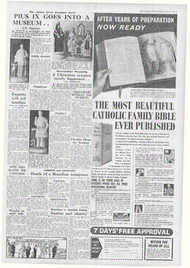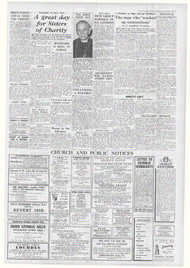Page 4, 27th November 1959
Page 4

Report an error
Noticed an error on this page?If you've noticed an error in this article please click here to report it.
Tags
Share
Related articles
An Essex Martyr
New Hymn In Honour Of The 'forty'
Appointments
Lilatenar Of Tbc Tacell
Episcopal Engagements
Blessed John Beche: a martyr of the Brentwood diocese
THE TRIAL OF COLCHESTER'S LAST ABBOT
By Maurice P. Fitzpatrick
ON St. John's Green, Colchester, not far from the bus park. there stands a fine and imposing gatehouse; it dates from about the year 1420 and is all that now remains. apart from the 16th century precinct wall, of the great Benedictine Abbey dedicated to St. John the Baptist.
On March 25 in the year 1533 the reigning abbot, Thomas Barton, died, and it was over two and a half months later before a successor was appointed. The man who came to Colchester in the troublous year of 1533 was John Beche.
There are very fee facts known concerning his early life. He was a student at Oxford in 1511. where he received the degrees of Bachelor of Sacred Theology and Doctor of Divinity. He eventually became the 26th Abbot of the great Benedictine Abbey of St. Wettiergh's, Chester (which is now Chester Cathedral) and he remained in this office until 1530. Three years later he was elected Abbot of St. John's, Colchester.
They signed
ON March 30, 1534, Abbot Beche took his scat in the House of Lords. In that year, the Act of Supremacy was passed by which Henry VIII made himself Head of the Church in England.
When the deed of this act was presented to the Abbot of St. John's on July 7 he, the Prior, and the community of 14, signed their agreement to the Act. It may be wondered why the Abbot and his monks appeared to agree, without demur. There are several reasons; the best, no doubt, is that put forward by Cardinal Gasquet.
So many bishops, abbots, and priests felt that this break with Rome was of a temporary nature the king. at the momeet, being weakened by evil passions and evil counsellors. One could temporise and accept the king as head of the Church in temporal matters, though it was quite impossible to conceive him as being the Head in matters spiritual.
7 en Martyrs THE following years were uneasy and uncertain. In 1535, Sir Thomas More and Cardinal John Fisher. together with the eight religious, suffered death for their defence of the supremacy of the
See of Rome. In the following year, Thomas Cromwell was VicarGeneral to the king. the lesser monasteries were suppressed, and in 1537 further religious suffered death for their faith.
Now the time had come, in Cromwell's plans, for the suppression of the greater monasteries; and on November 6, 1538. a commission was granted to Rowland Lee, Bishop of Coventry, to dissolve the Abbey of St. John at Colchester.
No surrender
THE Abbot denied the king's right to suppress his monastery. Very quickly, a certain Sir John Seynclere called upon Abbot Bache and he sent in his report to Cromwell on November 21. John Beche had asked his visitor what the Abbot of St. Oswyth had done respecting his Priory and he had been told that this Abbot was an honest and true man, the king's subject who had said that himself and his house belonged to the king and that if called upon to surrender his house, he would do so.
Abbot Beche had then told Sir
John Seynclete that he had not said the king would never have his house. Indeed, he could take it by force. But, for himself, it would be " agayne my will and agayne my hart, for I know by my lernyng that he cannot take yt by right and law ". His visitor had told him to forget some of his Oxford learning because it could cause him to be hanged, which was what he deserved.
Abbot Beche was soon arrested .and sent to the Tower of London. Here he remained until March 20, 1539, and there are no existing records stating the conditions under which he suffered this imprisonment. He was taken back to Colchester and reiroprisoned, probably in the dungeons of the Castle.
High treason
DURINCi this time. the Abbot had not been accused of any
crime, but efforts acre betne made to arraign him for the capital charge of high treason. It was not until the early days of November that evidence had been obtained— by what means is not known—by which it was hoped to bring about his condemnation.
Edmund Trawl/Ian, the Abbot's servant, said that his master denied that the king could suppress the Abbey because it was above the
yearly value of 300 marks. He would never surrender the Abbe). and its lands because it was against his conscience so to do. Further, he wished to God that every Abbot was of the same mind as himself, respecting this surrender. Respecting John Fisher and Thomas More. the Abbot had said: —They died like good men."
A second witness procured against John Beche was Thomas Nutlet-se, a physician who had known the Abbot since the instaIla lion at St. John's. He said that the Abbot had told him that the break with Rome was because the Pope refused to annul the king's marriage with Catherine and permit him to marry Anne. This was
the real reason why he had appointed himself head of the Church.
No Record
RoBERT ROWSE, a mercer of Colchester, a as a third witness. To him, Abbot John Beche had spoken in favour of the Pope, he had confirmed the previous statement concerning the covetousness of the king, he was grieved at the execution of More and Fisher, and, regarding the Northern Rising, he had spoken in its favour and had hoped for its success.
Some time during this same month of November, Abbot Beebe was brought to trial in Colchester. There is no record af the indictment under which he was charged nor any account of the proceedings. He was, however, found guilty of treason and on December 1, 1539, was hanged, drawn, and quartered on a hill just outside of the city.
The trial, condemnation, and death of Abbot Beetle followed the same pattern of the proceedings taken against the Abbots of Glastonbury and Reading who suffered martyrdom in November of that same year. It was an ordered plan designed to strike terror into the hearts of lesser men who might have ideas in their heads to withstand the tyranny of their king.
Dispersed
EVEN before the martyrdom of the last Abbot of Colchester, the treasures of his Abbey had been received into the king's treasury. The monks were dispersed. some, however, receiving pensions.
It is not certain what happened to the Abbey itself and its buildings immediately following the Suppression. Some writers say that most of it was purled down and the materials used in the construction of new edifices. Others maintain that this was not so but that the Abbey and its lands were let out to a variety of tenants.
Today. the Abbey Gatehouse on the Green is, indeed, the memorial and only remaining memory in this City of Blessed John Bede: and the sons of St. Benedict. His feast is kept on December 1 in the diocese of Brentwood.
blog comments powered by Disqus









